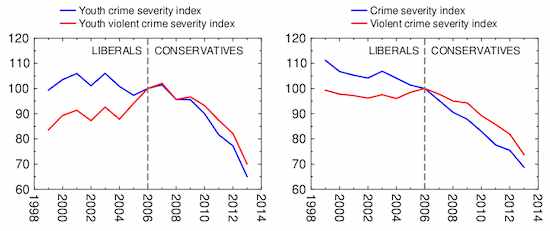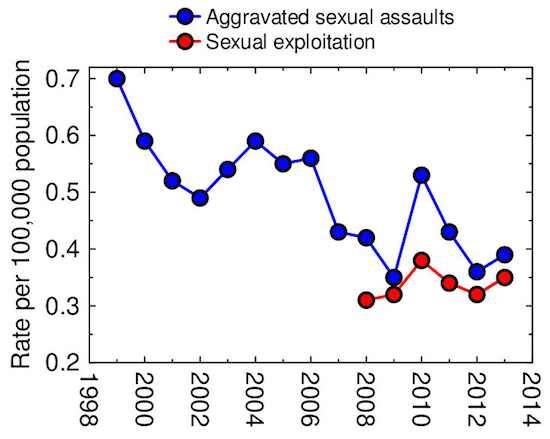By Sierra Rayne ——Bio and Archives--August 23, 2014
Canadian News, Politics | CFP Comments | Reader Friendly | Subscribe | Email Us
 These types of trend reversals are consistent for other crime indicators as well. In the seven years up to 2006 under Liberal rule, the youth crime severity index was up one percent -- or effectively unchanged, and certainly not declining. Since 2006, the index is down an impressive 35 percent. Same story for the general violent crime severity index: up one percent under the Liberals between 1999 and 2006; down 26 percent under the Conservatives between 2006 and 2013. The crime severity index only declined 10 percent over seven years under the Liberals compared to 31 percent over the same length of time under the Conservatives.
When we examine specific offenses and categories, the differences are reinforced. Almost all major crime categories and specific violations saw substantially greater declines under the Conservatives compared to the Liberals.
These types of trend reversals are consistent for other crime indicators as well. In the seven years up to 2006 under Liberal rule, the youth crime severity index was up one percent -- or effectively unchanged, and certainly not declining. Since 2006, the index is down an impressive 35 percent. Same story for the general violent crime severity index: up one percent under the Liberals between 1999 and 2006; down 26 percent under the Conservatives between 2006 and 2013. The crime severity index only declined 10 percent over seven years under the Liberals compared to 31 percent over the same length of time under the Conservatives.
When we examine specific offenses and categories, the differences are reinforced. Almost all major crime categories and specific violations saw substantially greater declines under the Conservatives compared to the Liberals.
 Note that rates for homicide, serious assaults, and forcible confinement/kidnapping increased under the Liberals, and then decreased significantly under the Conservatives. Not a single major crime category has increased under the Conservatives.
Thus, when I read Steve Sullivan's article at iPolitics.ca questioning "Is Canada getting safer? Nobody really knows," I'm forced to wonder what crime data he is looking at that the rest of us are not. Claims such as "the truth in statistics is in the eye of the beholder. Stats tell different stories to different people, depending on the sort of story they want to hear" are simply wrong. There is objective truth in statistics -- even, and especially, crime statistics. To claim otherwise is anti-science.
Sullivan claims that there is some "not-so-good news" in the latest crime data, and that "the number of aggravated sexual assaults, child pornography and sexual exploitation offenses went up." First off, we are always most interested in rates (normalized to population), not total numbers. As well, the rate for aggravated sexual assaults (i.e., "Sexual assault, level 3, aggravated") is very low, on the order of 0.4 per 100,000 population, and because it is very low, it has a lot of year-to-year variability that far more common offenses often do not. Sexual exploitation is in the same boat, with approximately the same rate as aggravated sexual assaults.
Aggravated sexual assault data goes back to 1998, whereas reliable sexual exploitation data starts in 2008. Looking at the raw data shows us clearly that there was not any meaningful increase in these offenses over the past year.
Note that rates for homicide, serious assaults, and forcible confinement/kidnapping increased under the Liberals, and then decreased significantly under the Conservatives. Not a single major crime category has increased under the Conservatives.
Thus, when I read Steve Sullivan's article at iPolitics.ca questioning "Is Canada getting safer? Nobody really knows," I'm forced to wonder what crime data he is looking at that the rest of us are not. Claims such as "the truth in statistics is in the eye of the beholder. Stats tell different stories to different people, depending on the sort of story they want to hear" are simply wrong. There is objective truth in statistics -- even, and especially, crime statistics. To claim otherwise is anti-science.
Sullivan claims that there is some "not-so-good news" in the latest crime data, and that "the number of aggravated sexual assaults, child pornography and sexual exploitation offenses went up." First off, we are always most interested in rates (normalized to population), not total numbers. As well, the rate for aggravated sexual assaults (i.e., "Sexual assault, level 3, aggravated") is very low, on the order of 0.4 per 100,000 population, and because it is very low, it has a lot of year-to-year variability that far more common offenses often do not. Sexual exploitation is in the same boat, with approximately the same rate as aggravated sexual assaults.
Aggravated sexual assault data goes back to 1998, whereas reliable sexual exploitation data starts in 2008. Looking at the raw data shows us clearly that there was not any meaningful increase in these offenses over the past year.
 Yes, technically there was an increase from 2012 to 2013. But look at the inter-annual variability over the past six years. We shouldn't try to read anything into year-to-year changes in crime rates unless they are either (1) massive, or (2) part of a clear multi-year trend, or (3) involve a major policy shift during the interim, or any combination thereof. Obviously, neither of the rate changes for these two offenses since 2012 meet these basic criteria. Ergo, they shouldn't be discussed in the media absent this contextualization, lest the oversimplified analyses mislead the public.
Sullivan goes on to note that perhaps fewer people today are reporting crimes than they were in the past, and thus, the crime rate reduction may be in part -- perhaps large part, the question isn't answered -- simply due to less crime being reported, rather than an actual reduction in the occurrence of crime. Perhaps, but it is unclear how you would reliably measure unreported crime. Getting a representative sample with accurate responses that could be verified appears nearly impossible. Not all events that people think are a certain type of crime are, in fact, that type of crime -- or indeed, any type of crime whatsoever.
And are there really a large number of serious crimes -- the ones we are most concerned about as a society, such as homicides, aggravated assaults, and high-value property theft or destruction -- that are becoming progressively less likely to be reported to the police over time? If so, what is the reason/mechanism for such an unsubstantiated trend? Do we really have any solid evidence to support this theory, or is it just another weak hypothesis employed in an attempt to discount the proven effectiveness of tough-on-crime law enforcement approaches in favor of softer methods (which are notoriously ineffective)? Indeed, wouldn't we expect crime reporting rates to increase -- not decrease -- during a tough-on-crime administration, since victims might rationally expect the public sector to respond more vigorously towards the illegal act, punish the perpetrators, help the victims, and generally seek to deter more occurrences? Perhaps the actual occurrence of crime under the Conservatives has decreased even more than reporting statistics would suggest?
The public should still be concerned about high crime rates, despite their substantial decline over the past two decades. Rates for violent crime and total crime are still 208 percent and 72 percent, respectively, higher than they were back in 1963. If trends through the 1960s are any indication, crime rates in the 1950s were far lower. Compared to this era, we still have "a tidal wave of criminal chaos."
There is nothing wrong with the silent majority seeking a more peaceful, less crime-ridden society. Canadian crime statistics over the past seven years suggest the Conservative Party has us on that path.
Yes, technically there was an increase from 2012 to 2013. But look at the inter-annual variability over the past six years. We shouldn't try to read anything into year-to-year changes in crime rates unless they are either (1) massive, or (2) part of a clear multi-year trend, or (3) involve a major policy shift during the interim, or any combination thereof. Obviously, neither of the rate changes for these two offenses since 2012 meet these basic criteria. Ergo, they shouldn't be discussed in the media absent this contextualization, lest the oversimplified analyses mislead the public.
Sullivan goes on to note that perhaps fewer people today are reporting crimes than they were in the past, and thus, the crime rate reduction may be in part -- perhaps large part, the question isn't answered -- simply due to less crime being reported, rather than an actual reduction in the occurrence of crime. Perhaps, but it is unclear how you would reliably measure unreported crime. Getting a representative sample with accurate responses that could be verified appears nearly impossible. Not all events that people think are a certain type of crime are, in fact, that type of crime -- or indeed, any type of crime whatsoever.
And are there really a large number of serious crimes -- the ones we are most concerned about as a society, such as homicides, aggravated assaults, and high-value property theft or destruction -- that are becoming progressively less likely to be reported to the police over time? If so, what is the reason/mechanism for such an unsubstantiated trend? Do we really have any solid evidence to support this theory, or is it just another weak hypothesis employed in an attempt to discount the proven effectiveness of tough-on-crime law enforcement approaches in favor of softer methods (which are notoriously ineffective)? Indeed, wouldn't we expect crime reporting rates to increase -- not decrease -- during a tough-on-crime administration, since victims might rationally expect the public sector to respond more vigorously towards the illegal act, punish the perpetrators, help the victims, and generally seek to deter more occurrences? Perhaps the actual occurrence of crime under the Conservatives has decreased even more than reporting statistics would suggest?
The public should still be concerned about high crime rates, despite their substantial decline over the past two decades. Rates for violent crime and total crime are still 208 percent and 72 percent, respectively, higher than they were back in 1963. If trends through the 1960s are any indication, crime rates in the 1950s were far lower. Compared to this era, we still have "a tidal wave of criminal chaos."
There is nothing wrong with the silent majority seeking a more peaceful, less crime-ridden society. Canadian crime statistics over the past seven years suggest the Conservative Party has us on that path.View Comments
Sierra Rayne holds a Ph.D. in Chemistry and writes regularly on environment, energy, and national security topics. He can be found on Twitter at @srayne_ca